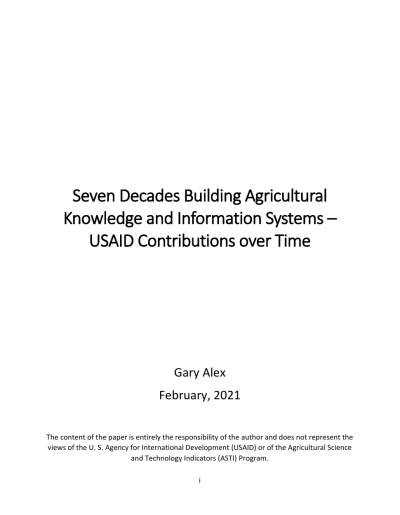This review complements a data set of estimates of USAID funding for agricultural research, extension, and education over the period 1950 to 2017. For most of this period, agriculture was a priority investment area for USAID as a means of preventing famine, spurring economic growth, reducing rural poverty, promoting political stability, and conserving natural resources. Agricultural research, extension, and education together came to be considered the core of the agricultural knowledge and information systems (AKIS), key to innovation necessary to increase production and productivity. The three AKIS sub-sectors accounted for about 30 percent of USAID agricultural funding.
Total USAID funding for AKIS sub-sectors amounted to $8.3 billion current US dollars (equivalent to $15.6 billion constant 2012 dollars) – 61 percent for research, 29 percent for extension, and 10 percent for education. This involved 1472 projects in 119 countries. Funding estimates include both direct delivery of the services and investments in development of local capacity for their provision. In early years, emphasis was on extension and education with establishment of agricultural universities and government extension and research programs. After the demonstrated successes of the Green Revolution, investments increased with the 1980s representing the peak years for AKIS investments. Funding declined substantially in the 1990s until rebounding around 2010.
Broad trends are not surprising. Early projects often featured the transfer of US technologies and institutional structures. By the 1980s, projects became more tailored to local country conditions with more participatory approaches, better understanding of rural societies and farming systems, and greater integration with broader rural development efforts. By the late 1980s, focus had shifted from working exclusively with public technical agencies to more pluralistic systems with entities in both the public and private sector. A later shift saw projects with AKIS funding included as part of a wide range of activities across the broader agricultural innovation system (AIS) or a specific commodity value chain. In later years, funding for education declined; extension emphasized direct service provision through private sector providers; and research shifted to global programs.
The overall AKIS investment program contributed substantially to global agricultural production increases and country capacity development. Still, many projects fell short of expectations with sustainability a common problem. Local commitment to investments was often the critical determinant of success. Many lessons have been learned from AKIS investments over the years, but these have not always been incorporated into later projects.
The environment for AKIS programs and investments has changed dramatically, but additional investments in agricultural research, extension, and education are likely essential to provide the knowledge and information for agricultural systems over the next fifty years.
Such investments must be based on a clear-eyed understanding of past experience and grounded in local commitment to the AKIS programs and their objectives. New approaches and mechanisms for AKIS investments will demand innovation and ingenuity on the part of development practitioners. Options may include: a new focus on research, perhaps with more attention to the country level; support to improving efficiency and quality of extension services; targeted assistance to improve relevance of agricultural education; and new mechanisms for engaging university partner capacities.

